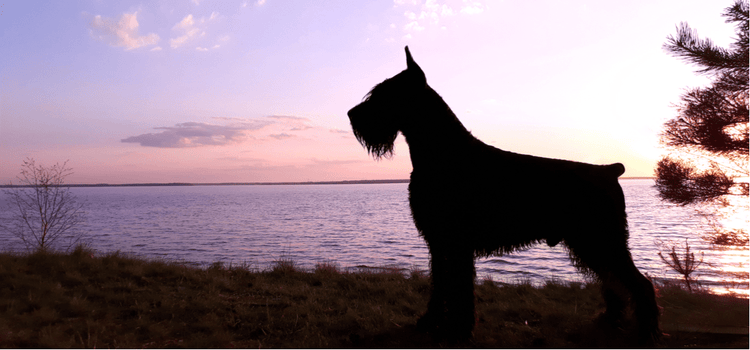
Choosing a Giant Schnauzer
For many people, the schnauzer is considered the perfect family pet. Available in three different sizes, the schnauzer is a tough and hardy companion as well as protector. With their classic beard and long eyebrows, this breed is easily recognizable all over the world.
History and Origin
The schnauzer hails from Germany and is divided into the miniature schnauzer, standard schnauzer and giant schnauzer. Of the three sizes of schnauzer, the standard is considered the prototype and is the oldest. Even though these schnauzers may appear similar, they are all considered separate breeds.
All schnauzers are thought to have developed in the kingdoms of Wurttemberg and Bavaria, and the standard schnauzer has been around since at least 1492. Paintings of that era depict the schnauzer as a household companion. The dog was not only part of the family but was also used to chase rats and guard produce carts in the marketplace.
The giant schnauzer was developed by crossbreeding with larger breeds, such as the Great Dane. The purpose was to produce a larger dog with the schnauzer’s love of the family and guarding instincts to drive cattle. Some feel that the giant schnauzer is related to the Bouvier des Flandres.
Prior to 1910, the schnauzer was not known outside of Germany. After World War I, the breed became popular throughout the world. During the war, the giant schnauzer was used in policing and as a messenger.
Today, the giant schnauzer is used in some parts of the world as a police and guard dog. The giant schnauzer belongs to the working group of the American Kennel Club.
Appearance and Size
The schnauzer is a compact sturdy dog. All sizes have a stiff wiry hair coat with arched bristling eyebrows, whiskers and a beard. The most common coat color is salt and pepper but black is also available. In Germany, black is the more common color.
Most schnauzers in Germany have cropped ears but in the United States, cropped and uncropped are seen. Uncropped ears sit high on the head and fold forward.
The giant schnauzer stands 25 to 28 inches at the shoulder and weighs around 70 to 75 pounds.
Personality
All schnauzers are intelligent and reliable dogs. They are very protective of their family and make good watchdogs. The giant schnauzer is an imposing dog but friendly and loving to people he knows.
Home and Family Relations
The schnauzer is a wonderful family pet and is quite tolerant of children. They are often wary of strangers and will protect their family by alerting their owners of the presence of intruders.
Training
Schnauzers tend to be independent dogs and do not tolerate harsh training or reprimand. They are easy to train, as long as positive reinforcement techniques are used. The giant schnauzer is often trained as a guard and watchdog.
Special Concerns
Giant schnauzers are intelligent dogs and become bored easily and, if left alone for extended periods of time, destructive behavior may develop.
The giant schnauzer may become aggressive if not properly socialized early in life.
In order to keep their coat clean and tangle free, frequent grooming and clipping is necessary. Trips to the groomer are also necessary to maintain the classic schnauzer facial appearance.
Common Diseases and Disorders
In general, the giant schnauzer is a healthy dog with few medical concerns. However, the following diseases or disorders have been reported:
- Hypothyroidism results when the thyroid gland does not function adequately. Without enough thyroid hormone, illness can occur.
- Gastric torsion, also known as bloat, is a life-threatening sudden illness associated with the stomach filling with air and twisting.
- Atopy is an itchy skin disease of animals that is caused by an allergy to substances in the environment.
- Melanoma is a tumor arising from melanocytes, which are the cells that produce pigment.
- Lipomas are benign fatty tumors of the subcutaneous tissue.
- Hip dysplasia is a malformation of the hip joint that results in pain, lameness and arthritis.
- Progressive retinal degeneration (PRD) is a disease that causes nerve cells at the back of the eye to degenerate. The condition usually begins in older pets and can lead to blindness.
- Epilepsy is a seizure disorder that develops between the ages of 2 to 5 years.
- Cataracts cause a loss of the normal transparency of the lens of the eye. The problem can occur in one or both eyes and can lead to blindness.
- Cryptorchidism is a condition in which one or both testicles do not descend into the scrotum.
- Diabetes is a disease of the pancreas related to insufficient amounts of insulin production.
- Pancreatitis is an inflammation of the pancreas that results in lack of appetite, vomiting and abdominal pain.
- Glaucoma is a disease of the eye that develops when the pressure within the eye increases which can lead to blindness.In addition, the schnauzer is prone to bladder infections and allergic skin diseases. Intact male dogs may develop sertoli cell tumors .\
Life Span
- The average life span of the giant schnauzer is 10 to 12 years.
- We realize that each dog is unique and may display other characteristics. This profile provides generally accepted breed information only.